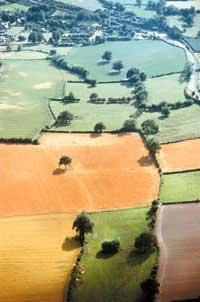The man leaves trace
2004/01/01 Rementeria Argote, Nagore - Elhuyar Zientziaren Komunikazioa Iturria: Elhuyar aldizkaria

Man needs to dominate a harsh environment, as the song says. Urgent or not, it dominates the environment in which it lives and its influence can be seen anywhere. Look, if not, at the towns and cities where most of the world's population lives: the laws of nature cannot be said to rule.
Human beings need to be in contact with nature... As for survival, the human being inevitably depends on the environment. It exploits local sources to obtain raw materials: it obtains from nature food, fuels and substances used in the production of various products.
Although reality is unique, both perspectives are the two sides of the same coin. But is the relationship between nature and humanity in balance? To answer this question arises the concept of ecological footprint. The ecological footprint is a tool to measure human pressure on the world's ecosystems.
The ecological footprint measures the damage that man exerts on nature in his activities and is expressed in units of fertile ground surface, which means that the influence of human activities, both the exploited lands and the waste generated, is transferred to surface units. For the purposes of simplification, only the area of land necessary for food and wood, that for infrastructure and that necessary to absorb the carbon dioxide generated by the combustion of fossil fuels is considered.
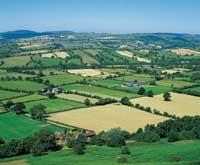
All these terms are expressed in surface units (or hectares) using mathematical formulas. Thus, for example, the carbon dioxide produced by the fuel consumed by a car is transformed into hectares. Logically, the ground representing the surface unit is not real. The unit has been defined by a biologically rich average terrestrial surface. This unit of surface has been defined according to the type of land, so that a unit is 0.3 hectares (ha) of rural land, 0.6 ha of forest, or 2.7 ha of meadow or 16.3 ha of sea.
All these areas have average fertility, a real hectare of very productive soil is expressed with more surface units than a low productivity area with the same dimension.
Let's analyze what factors are used to calculate the ecological footprint. Suppose there are three modes of travel to work: car, bus and bicycle. What is the least ecological footprint produced in these three? In the case of cycling, more energy will be needed at breakfast; if cereals have been eaten, for example, the land surface used for the production of these cereals is calculated. To this is added the fuel used in the process of making the bicycle, which will be brought to surface units. It is done in a similar way to the car and the bus, but since the power source is gasoline, it takes into account the amount of liters of gasoline that have been used, the space they occupy on the road, the maintenance of the road, etc.
Calculated as average, it can be said that the least ecological footprint is produced using the bicycle, the bus is almost double and if you choose to go by car can be ten times greater.
To calculate an individual's ecological footprint, the means of transport are taken into account, but also other factors such as buying local or imported products, bathing or showering, and how often, the amount of waste generated...

However, most of the calculations are done on average, taking into account a whole municipality, or without moving to surface units such as the city, the region, the state, etc., that is, on hectares of land. Thus, the ecological footprint of the donostiarras is an average of 3.64 ha/year, about twice as much as San Sebastian can bear. The ecological footprint of a Navarro is an average of 3.47 ha.
The chart below highlights the difference between countries of the world. The countries that use the most advanced technologies are those that leave the greatest mark, since they consume more. The countries that leave the smallest mark are underdeveloped.
The average footprint of the world's population is 2.8 units of surface, according to 1996 United Nations data. To determine whether the land can withstand this level of exploitation, the area corresponding to each human being has been calculated, corresponding to two hectares or surface units. The calculation takes into account all the fertile areas of the world: rural lands, forests, meadows and coasts. 12% of this area has been eliminated as necessary for the maintenance of biodiversity. And they have divided the remaining surface between the population.
If we look at the data, the conclusion is clear: man is exploiting more than he is entitled to. In particular, each of the six billion inhabitants of the Earth exploits an average area of 0.8 hectares that would correspond to it. It is clear that, following that path, the future appears dark.
Advantages yes, but also barriers
However, as it is a measurement instrument, it is limited, since it cannot take into account all the factors, if all the affected terms were taken into account, it would not be useful, only the data collection would be too long.
Simplicity has advantages as it facilitates the understanding of the concept itself. This indicator highlights the environmental impact of personal lifestyle, consumption habits. Somehow, it makes the consumer more aware of the damage their needs generate. This facilitates awareness of the need to change these habits.
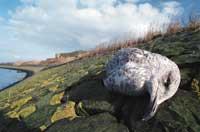
However, improvements can be made to measure the ecological footprint of peoples. In fact, it is not taken into account that the production of the products consumed has also occurred on external ecosystems, since the market currently extends to everyone. What is calculated is the consumption of each country, for which the imported is added to the domestic production and the exported is eliminated.
Thus, if we buy in Euskal Herria a car produced in Germany, the ecological footprint generated by that car is counted in EH.
Although the product is sold outside, waste generated during production is included in the country's consumption. This means that the importing country does not assume the footprint corresponding to the waste generated during production. Following the example above, the footprint of waste generated during car production is counted in Germany.
Consequently, some ecological remains are inflated. Imagine: Although Irish consumption habits are similar to those in the UK, the Irish footprint is four units larger. In fact, Ireland sells a lot of vegetables abroad and the residues generated in the crop increase its ecological footprint.
The same happens in countries with a great tourist influx: the ecological footprint generated by people from outside is not counted in the municipality of origin but in the tourist destination.
The ecological footprint certainly has features that can be refined. In order to be reliable as a measuring instrument, it must be precise, which implies a large number of data, but at the same time, due to its simplicity of handling, the number of data is necessarily limited. The key is the balance between both characteristics.
The objective of the ecological footprint is to put in figures the damage that the human being exerts on the medium to discover if human activities are unsustainable. However, it is not easy to say to what extent each people must lower their ecological footprint to be sustainable. It is a matter of will, not to be said. Perhaps we should look at the words of the song: hard money has no heart, they will unite it hard and tight so that it does not grow on men.
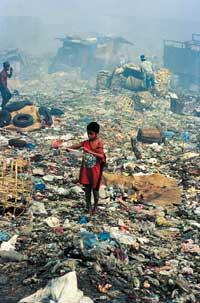
The footprint of underdeveloped peoples is less than the world can bear. Does that mean they are sustainable? If we only look at ecology, they are certainly sustainable. But we must not forget that sustainability also has a social and economic dimension, and underdeveloped countries, by definition, are not economically sustainable, and usually also present large gaps at the social level.
Therefore, the ecological footprint highlights the differences between peoples. In fact, developed countries not only exploit resources within their limits, but also affect the ecosystems of other countries.
Think that the Spanish ecological footprint is approximately 5.4 surface units and ecological capacity 2.52 units. Therefore, each inhabitant of Spain has an ecological deficit of almost three surface units, or what is the same, outside the State three surface units are used to maintain their standard of living. And in France the same thing happens, since the ecological footprint is 7.27 units of surface and the ecological capacity of 4.27.
If instead of a quick shower you fill the bathtub, you don't go the right way. Everyday consumption habits to reduce the ecological footprint are the ones to change.
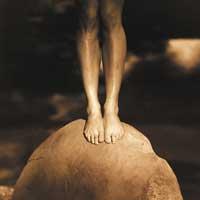
For example, if possible, better move on foot or by bike and take public transport to travel long distances. Try not to buy the items that you do not need, because for its manufacture the raw materials have been exploited and if then you do not take advantage of it will become waste, also your pocket will appreciate it. If we select local products we know that transport has become less polluted and we prevent our ecological footprint from being attributed to other countries.
That your trash is filled with cans, plastic covers and other containers? You can start choosing products with fewer wrappers when you make the purchase.
If you want to measure your ecological footprint, there are pages on the Internet and you only have to answer a questionnaire. In http://www.euskadi.net/ihitza/ihitza10/10kontsumista_e.htm, for example, you have a short questionnaire in Basque. Although the latter is not in Basque, you can choose from many languages and it is very specific: http://www.myfootprint.org
Keep in mind that although major decisions are delegated in States, every citizen can make the effort and take responsibility.


Gai honi buruzko eduki gehiago
Elhuyarrek garatutako teknologia





